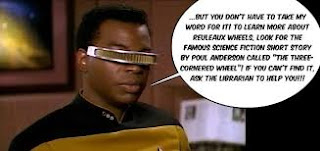"He reached the highroad and started toward the city. There was considerable traffic, food and raw materials coming from the hinterlands, handmade goods going back. Professional porters trotted under loads too heavy for Schuster even to think about. Fastigas dragged travois with vast bumping and clatter." (p. 225)
These three sentences describe a transport system and an economy. Apparently a travois is more efficient than a wheeled vehicle on some surfaces like soft soil, snow or a forest floor - although not on a highroad.
Wheels facilitate motion as coins facilitate exchange. They have similar roles. HG Wells's Martians used tripodal legged vehicles in The War Of The Worlds. And there are quadrupedal All Terrain Armored Transports in Star Wars films.

10 comments:
Kaor, Paul!
And that use of "travois" at a location where, on almost any other world wheeled vehicles would have been used, was a clue something was not right in Larsum. And porters would have best used in cities and towns for transporting goods from wheeled vehicles for far shorter distances. So using porters like that was another sign of inefficiency.
Ad astra! Sean
If they have an analogue to the horse (and probably to the ox, too) why use bipedal porters?
That's inefficient. Human porters were only used for long-distance overland transport in places like parts of subsaharan Africa or the pre-Columbian Americas, where there just weren't any domesticated load-bearers.
Robotic four-legged cargo carriers are under deployment now for military purposes; and four-legged and two-legged robots for other roles.
Kaor, Mr. Stirling!
I know, I agree. It was grossly inefficient, using porters for long distance transporting of goods. The reason for that, in Larsum, was the theological objection to using the sacred wheel for merely secular purposes.
I thought long, stilt legged machines (or robots?) of the kind we saw in Wells' THE WAR OF THE WORLDS would not be practical?
Ad astra! Sean
Sean: Boston Robotics is making them -- they can go where wheeled vehicles can't. Anywhere humans can walk, in fact.
Like wow.
On Ivanhoe, the fastigas can be used as pack animals and also drag travois so there is no need for long-distance human porters.
Kaor, Mr. Stirling and Paul!
Mr. Stirling: I'm surprised! Another reason to check out Boston Robotics, and in my own home state of MA! I never thought robotics would get so advanced in my lifetime.
Paul: Yes, but the use of fastigas and travois plus long distance porters on Ivanhoe still had severe disadvantages when compared to how much MORE could be transported using wheeled vehicles. Again, we come back to the objection the religion of Larsum had for using the wheel for secular purposes.
Ad astra! Sean
Sean: the thing is, while wheels are more efficient than pack animals, pack animals are more efficient than human porters. It takes more, and more valuable, food to keep humans going than it does horses, camels or oxen. The same would probably be true on Ivanhoe.
(Pack trains only stopped being used in Britain very gradually, starting in the late middle ages, when the road network improved enough to make long-distance transport by wagon more economical. "Drover's trails" were once how a lot of goods from remote regions got out to market.)
Kaor, Mr. Stirling!
I sit corrected. Pack trains were often more practical than wagons till roads were improved enough for wagons to be economical.
So pack trains of fastigas were used on Ivanhoe.
Ad astra! Sean
More on wheel less transport:
http://cup.columbia.edu/book/the-camel-and-the-wheel/9780231072359
or this summary article
https://archive.aramcoworld.com/issue/197303/why.they.lost.the.wheel.htm
Post a Comment